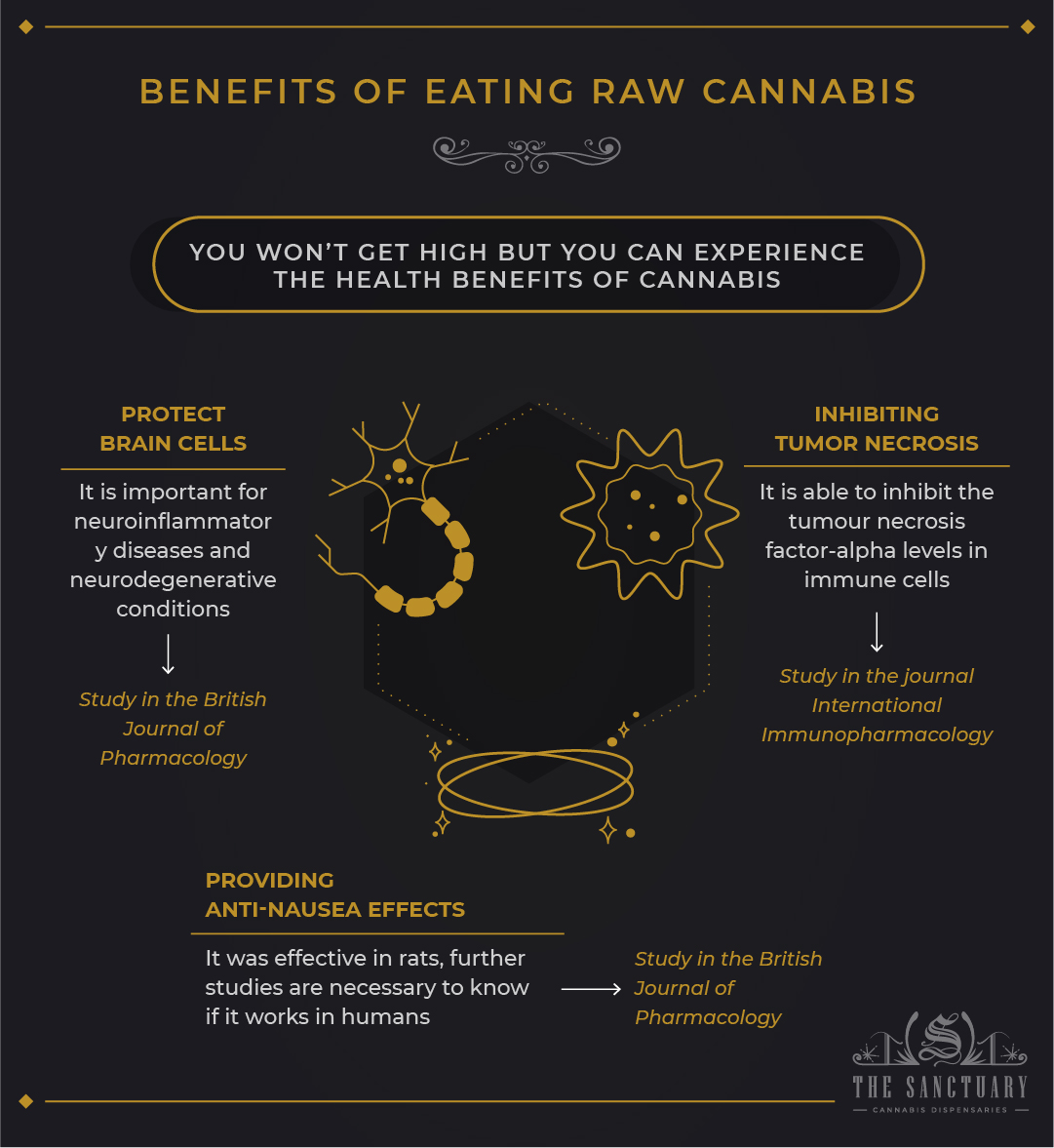Iftikhar Alam
Author
Reviewed by Cannabis Experts
Published on: November 9, 2020 | Updated on: July 21, 2024
If you enjoy eating edibles then perhaps you have considered if it is possible to eat raw weed all by itself.
It is a concept that has been debated at great length. Technically, yes you can get high from eating raw weed.
However, it is a really inefficient way to get high. You would have to eat about an eighth of top-shelf bud just to feel any sort of effects. Eating that many raw nugs is certainly not going to be appetizing.
Can eating raw cannabis get you high?
Weed plants in their raw form do not contain the psychoactive compound tetrahydrocannabinol (THC). Instead, they contain tetrahydrocannabinolic acid (THCA) which is the non-psychoactive cannabinoid that turns into THC when it gets heated to the proper temperature.
When cannabis is harvested and cured, the THCA slowly converts into THC. This is why curing is such an important process among other reasons. Activating THC is a process known as decarboxylation.
Benefits of eating raw cannabis

So you may not get high from eating raw weed, but there are other health benefits that you may get from eating it. According to many people that eat raw weed, they have felt therapeutic and health benefits from cannabinoids without experiencing any of the psychoactive effects.
It is not just heresay, studies are coming out that demonstrate potential benefits from eating THCA. In 2013, researchers determined that cannabinoids such as THCA can slow the growth and spread of certain cancer cells. Another study in 2012 found that both THC and THCA can act as neuroprotectants that promote brain health.
Raw cannabis is full of beneficial terpenes, vitamins, minerals, and antioxidants such as omega-3 and omega-6 fatty acids. It has also been found to be high in protein, amino acids, and fiber. Specific benefits include:
- Protecting brain cells: The British Journal of Pharmacology completed a study that found that THCA may have a protective effect on brain cells.
- Inhibiting tumor necrosis: A study by the International Immunopharmacology, tested the effects of raw cannabis. They found that THCA was successful in diminishing the tumor necrosis factor-alpha levels in immune cells.
- Providing anti-nausea effects: In a different study in the British Journal of Pharmacology, researchers examined the anti-nausea effect of THCA in rats. They found that it was effective in reducing nausea and vomiting. Furthermore, it showed that THCA could possibly be more effective than THC in the treatment of nausea and vomiting. Unfortunately, these studies did not suggest a direct correlation to humans.
Terpenes in raw cannabis
If you have heard of the “entourage effect” then you understand the importance of terpenes. Terpenes are an abundant compound in cannabis. They provide medical and therapeutic benefits and are capable of enhancing the effects of cannabinoids.
For example, terpenes such as limonene and myrcene are responsible for encouraging feelings of relaxation and calmness.
Unfortunately, terpenes are volatile and therefore break down at high temperatures. Eating raw cannabis allows you to consume the rich array of terpenes in cannabis without any degradation.
Flavonoids in raw cannabis
Flavonoids are also beneficial compounds that should not be overlooked. Flavonoids are a group of plant metabolites thought to provide health benefits through cell signaling pathways and antioxidant effects. These phytochemicals can also be found in certain healthy foods and beverages like kale, broccoli, blueberries, green tea, and much more.
Flavonoids are crucial to the benefits of cannabis. They are essential pigments for producing the colors needed to attract pollinating insects, and also to protect plants from UV rays and pathogens. Examples of flavonoids commonly found in weed include:
- Cannflavin A
- Cannflavin B
- Kaempferol
- Quercetin
- Anthocyanins
Ways to consume raw cannabis
There are a few ways to ingest raw weed. Some are easier to stomach than others. It is best to try each method to find your preference.
Juicing
Juicing is the most common way for people to consume raw cannabis. It is the best way to get all of the vitamins and minerals contained in cannabis while filtering out the fibrous plant matter that is tough for our bodies to digest.
Weed juice does not taste very good on its own so consider adding some fruit juice to make it more palatable.
If you plan on juicing raw weed then you will need a juicer. All parts of the cannabis plant are able to be juiced but in general, the leaves and buds are the easiest to work with. If juicing the buds feels blasphemous then just stick with the leaves and you should still get plenty of nutrients. The water content of a weed plant is not very high so you will not get much juice from a plant.
Smoothies
Make a smoothie with different fruits and ice plus some raw flower and weed leaves. This will be much more fibrous than the juice but it still harbors all the same benefits.
Try chopping your plant material before adding it to the blender in order to help the process of breaking it down.
As-is
Some people eat weed straight up as if it were lettuce. While this is by far the least appetizing way to consume weed, it is possible. Try chopping it up as finely as possible and adding it to a salad with different greens and vegetables.
Potential downsides of raw cannabis
Eating raw weed may be unappetizing but it can also expose you to potentially harmful bacteria such as salmonella and E. coli. It certainly would not be the first time weed has been found to have trace amounts of these different bacterias.
Also, some growers may use dangerous pesticides for their plants and that is something you do not want to eat. If you are interested in eating raw weed then get some plant material from a trusted source with organic farming practices.
Sources
Footnotes
- Lawrence RG. Pot in pans: A history of eating cannabis. Rowman & Littlefield; 2019.
- Lee M. Juicing raw cannabis. O’Shaughnessy’s, Winter/Spring. 2013.
- De Petrocellis L, Ligresti A, Schiano Moriello A, Iappelli M, Verde R, Stott CG, Cristino L, Orlando P, Di Marzo V. Non-THC cannabinoids inhibit prostate carcinoma growth in vitro and in vivo: pro-apoptotic effects and underlying mechanisms. British Journal of Pharmacology. 2013;168(1):79-102.
- Moldzio R, Pacher T, Krewenka C, Kranner B, Novak J, Duvigneau JC, Rausch WD. Effects of cannabinoids Δ(9)-tetrahydrocannabinol, Δ(9)-tetrahydrocannabinolic acid and cannabidiol in MPP+ affected murine mesencephalic cultures. Phytomedicine. 2012;19(8-9):819-24.
- Nadal X, Del Río C, Casano S, Palomares B, Ferreiro-Vera C, Navarrete C, Sánchez-Carnerero C, Cantarero I, Bellido ML, Meyer S, Morello G, Appendino G, Muñoz E. Tetrahydrocannabinolic acid is a potent PPARγ agonist with neuroprotective activity. British Journal of Pharmacology. 2017 Dec;174(23):4263-4276.
- Verhoeckx KC, Korthout HA, van Meeteren-Kreikamp AP, Ehlert KA, Wang M, van der Greef J, Rodenburg RJ, Witkamp RF. Unheated Cannabis sativa extracts and its major compound THC-acid have potential immuno-modulating properties not mediated by CB1 and CB2 receptor coupled pathways. International Immunopharmacology. 2006;6(4):656-65.
- Rock EM, Kopstick RL, Limebeer CL, Parker LA. Tetrahydrocannabinolic acid reduces nausea-induced conditioned gaping in rats and vomiting in Suncus murinus. British Journal of Pharmacology. 2013 Oct;170(3):641-8.
References
- Eating raw weed: Can it get you high?. Medical News Today. Accessed 4/7/2024.
- Can You Eat Weed? All You Need to Know About Marijuana Edibles. Healthline. Accessed 4/7/2024.
- Can You Eat Weed?. NuggMD. Accessed 4/7/2024.
The content provided on this blog is for informational purposes only and does not constitute medical, legal, or professional advice. Cannabis use is subject to local laws and regulations, which vary widely by jurisdiction. Always consult with a healthcare professional before starting any new treatment or altering an existing treatment regimen. The authors and publishers of this blog are not responsible for any actions taken based on the information provided herein. Use cannabis responsibly and in accordance with applicable laws. This blog is intended for adults aged 21 and over. The Sanctuary Dispensaries D186, D187.








